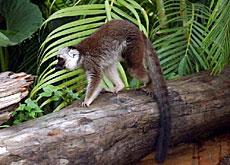Technology triumphs over nature at Zurich zoo

Building a Madagascan rainforest at Zurich zoo has posed huge technical and logistical challenges.
But the SFr52 million project, which opened on Monday, has also cast a spotlight on the role of conservation.
Some critics have questioned whether the money might have been better spent on saving a real rainforest rather than creating an artificial one.
From special insulating material for the roof, to the planting of 17,000 species of plants, not to mention tropical rainfall of 80,000 litres of water a day, nothing has been spared to faithfully reproduce a rainforest ecosystem.
“It seems to be a paradox,” said landscape architect, Günther Vogt. “We need all these technologies to create nature.”
Botanists grew seedlings in a plant nursery in Madagascar, as well as transporting plants of native Madagascan origin from Malaysia, Thailand and Florida.
Trees up to 12 metres in height were transported to greenhouses in the Netherlands, where they were acclimatised before continuing their journey to the zoo.
“We’re agreeably surprised by the way the plants have grown,” said project leader Andreas Hohl. “We never thought they would grow so quickly and so high in such a short time.”
“In two or three years, you won’t be able to see the roof anymore and originally we thought that might take up to seven years.”
Menagerie
The stock of animals includes lemurs, tortoises, flying foxes, birds and insects.
Meanwhile a complicated heating and ventilation system recreates the climatic conditions of the Masoala peninsula in Madagascar.
This means temperatures of 20-30 degrees Celsius, humidity of over 80 per cent and tropical rainfall of six millimetres per day.
Key to creating this tropical climate indoors is the ultra light-sensitive foil used for the hall’s roofing, which also possesses high insulation properties.
“Twenty years ago, it would have been impossible to build this installation,” said Hohl.
Unique
Madagascar is famed not only for the diversity of its wildlife but because so many of its plants and animals are found nowhere else in the world.
About 65 per cent of the country’s mammal species including all lemurs, over 70 per cent of its known plant species, over 80 per cent of its reptiles and amphibians, and 50 per cent of its birds are only found on the island.
Masoala, which has been a National Park since 1997, boasts the island’s largest block of tropical rain forest.
Zurich zoo has been contributing $10,000 a year for development projects around the park and has also committed itself to the long-term financing of the park’s running costs.
It’s a unique relationship, according to Matthew Hatchwell of the Wildlife Conservation Society, who was country director in Madagascar from 1996 to 2002.
“This is the closest link that’s been established between a zoo exhibit and a national park or a protected area on the ground,” he said.
“We’re hoping that it will become a model for future zoo exhibits around the world.”
Good investment
The exhibit was not specifically planned to save endangered species, and few plants in Masoala national park are directly threatened.
However, it is not impossible that one day some species might need to be reintroduced from Zurich.
For example, there are only two wild populations of the pitcher plant, and they happen to grow in an area that was hit by a cyclone in April 2000.
“They both survived, but it is a fragile situation,” said Hatchwell. “One could imagine at some point in the future, we discover that there are plants growing here in Zurich which for one reason or another don’t occur anymore in the national park.”
Hatchwell said he did not support the argument that the SFr52 million could have been better spent directly on conservation projects.
“The role of this rainforest as a showcase for Masoala, and Madagascar more generally, is extremely important and we shouldn’t underestimate that.
“It represents a very good investment in terms of conservation, because not only will this exhibit generate a long-term funding stream, but we’re hoping that a good proportion of the people who come through the exhibit will visit Madagascar and will therefore contribute to the economy of the country.”
swissinfo, Vincent Landon
Madagascar is 14 times the size of Switzerland.
It is the fourth largest island in the world and has a population of 15 million.
Only four per cent of the original rain forests of Madagascar are still completely intact.
Masoala is the largest national park in Madagascar.

In compliance with the JTI standards
More: SWI swissinfo.ch certified by the Journalism Trust Initiative










You can find an overview of ongoing debates with our journalists here . Please join us!
If you want to start a conversation about a topic raised in this article or want to report factual errors, email us at english@swissinfo.ch.